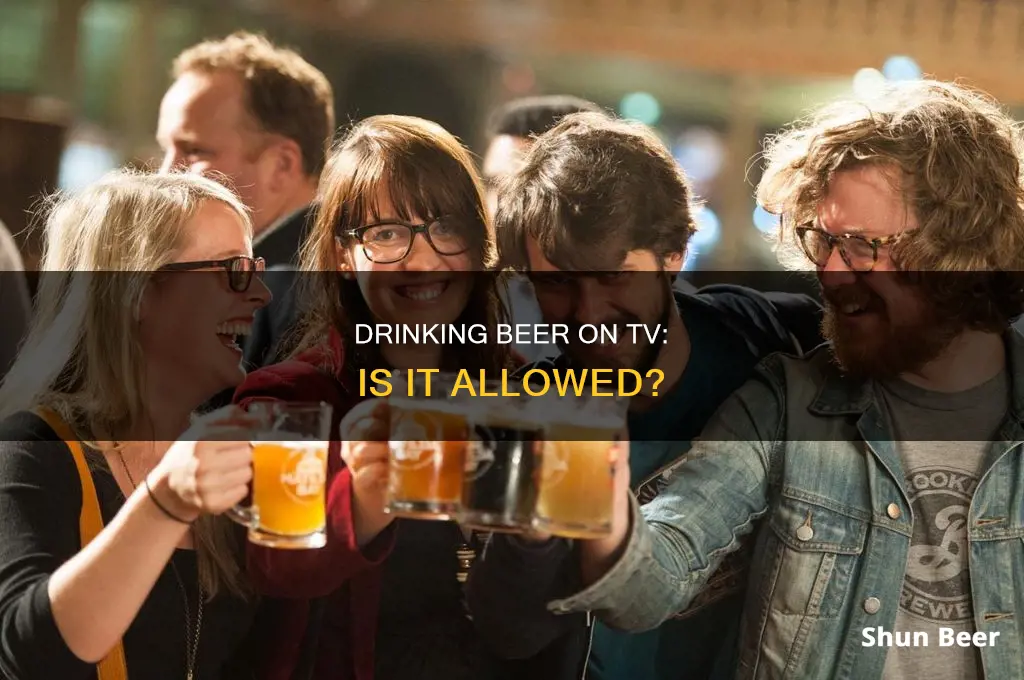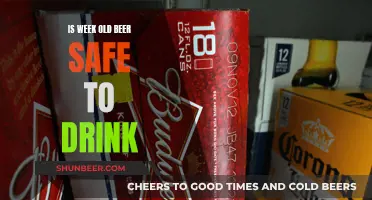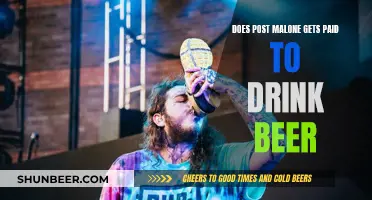
Beer commercials have long been a source of entertainment for viewers, but one thing that stands out is that you rarely see anyone drinking the beer. This has led to questions about whether it is illegal to drink beer on TV. Interestingly, there is no federal law or national broadcasting standard in the United States that prohibits the consumption of beer or other alcoholic beverages on television. The decision to not show beer consumption appears to be a self-imposed regulation by the television networks and the alcohol industry to avoid promoting alcohol to underage consumers. This regulatory thing, as it is often called, is not unique to the United States, as other countries like Canada have similar rules in place. While some networks are starting to reconsider this long-standing rule, it is unlikely to change anytime soon, and broadcasters continue to hold the line on not showing beer consumption in their commercials.
| Characteristics | Values |
|---|---|
| Can a person drink beer on TV? | No |
| Is it illegal? | No |
| Who enforces the rule? | TV networks |
| Is the rule changing? | Some networks are beginning to change it |
What You'll Learn

Beer commercials and actors drinking
Beer commercials are a common feature of television advertising, and often feature actors holding or pouring the beverage. However, it is rare to see an actor drinking beer in a television commercial. This is due to a long-standing rule that originates with television networks and broadcasters, rather than any federal legislation or policy.
The rule against showing beer consumption on television is not a legal requirement. The Federal Communications Commission (FCC) has stated that "Congress has not enacted any law prohibiting broadcast advertising of any kind of alcoholic beverage, and the FCC does not have a rule or policy regulating such advertisements". This was confirmed by a press officer at the FCC, who said that their rules do not prohibit drinking on camera.
Instead, the rule is a self-imposed restriction by the television industry. Tara Rush, senior director of corporate communications at Heineken USA, confirmed that the rule is "a regulation with the actual TV networks" and "a long-standing one". The Beer Institute, the voice of brewers and distributors, is also reluctant to go against network policy. Their director of communications, Megan Kirkpatrick, stated that "you will be as conservative as possible so you know it will get past all the networks" when creating an advertisement.
While there is no federal law prohibiting the display of alcohol consumption on television, the beverage industry has its own advertising codes that broadcasters are advised to follow. These codes include recommendations such as restricting alcohol advertising to media where at least 70% of the audience is over 21 years old, and not showing alcohol consumption that is rapid, excessive, or part of a drinking game. While these codes are voluntary, broadcasters are wise to adhere to them to avoid stirring calls for heavier regulation of alcohol advertising.
Some have criticised this self-regulation, arguing that a modest amount of restraint is appropriate given the negative effects associated with alcohol consumption. However, others see it as an unwarranted intrusion on the private sector by the television industry. There are indications that this may be changing, with some networks beginning to relax the rules around displaying alcohol consumption in advertisements.
Tramadol and Non-Alcoholic Beer: Safe Mix or Not?
You may want to see also

Beer advertising and government regulation
The Federal Communications Commission (FCC) has stated that Congress has not enacted laws prohibiting broadcast advertising for alcoholic beverages, and the FCC itself does not have rules or policies regulating such promotions. The decision to restrict the display of alcohol consumption on television lies with the television networks and broadcasters. This was highlighted in a Heineken ad featuring Neil Patrick Harris, where he is directed not to drink the beer on camera due to "regulatory things."
The self-regulation by the alcohol industry is a response to concerns over advertising to underage consumers. The Federal Trade Commission (FTC) has issued reports and updates on self-regulation, commending the spirits industry for its responsible advertising practices. The FTC's recommendations include restricting ad placement in media with large underage audiences and avoiding content with substantial underage appeal.
While there is no federal law or national broadcasting standard banning alcohol advertising, broadcasters are advised to respect the industry's advertising codes. Some states, like California, have attempted to introduce legislation to penalise advertisements that encourage minors to drink alcohol.
The complex nature of alcohol advertising regulations, with varying rules across different countries and networks, presents a challenge for advertisers. The absence of strict prohibitions, however, leaves room for interpretation and potential changes in the future.
Drinking Dr. McGillicudys Root Beer: Safe or Not?
You may want to see also

Beer advertising and industry self-regulation
In addition to legal regulations, the alcohol industry has implemented voluntary self-regulatory codes to prevent advertising that appeals to underage consumers. The three major alcohol supplier trade associations—the Distilled Spirits Council of the United States (DISCUS), the Beer Institute (BI), and the Wine Institute (WI)—have all adopted voluntary regulations to discourage underage drinking. These codes prohibit blatant appeals to young audiences and advertising in venues where most of the audience is under the legal drinking age.
Despite these efforts, studies have found that self-regulation in the alcohol industry is often ineffective at preventing content violations. For example, a study evaluating US beer ads during the National Collegiate Athletic Association (NCAA) basketball tournament games between 1999 and 2008 found that between 35% and 74% of the ads had code violations. The most common violations included associating beer drinking with social success and using content appealing to persons under 21.
To address these concerns, the Federal Trade Commission (FTC) has made several recommendations. These include creating independent external review boards to address complaints, raising the standard for the legal-age audience for ads, and adopting best practices for ad placement, content, and online advertising. By strengthening enforcement mechanisms and adopting industry best practices, the alcohol industry can improve compliance with self-regulatory codes without sacrificing legitimate advertising activities.
Jaw Surgery and Beer: What's Safe to Drink?
You may want to see also

Beer advertising and underage consumers
Beer advertising and its influence on underage drinking is a well-researched topic. Studies have shown that advertising budgets and strategies used by beer companies do influence underage drinking. The amount of money spent on advertising is a strong predictor of the percentage of teens who have heard of, preferred, and tried different beer brands.
The Federal Trade Commission (FTC) has reviewed the adequacy of the alcohol industry's self-regulation of advertising and marketing as it relates to underage youth. The FTC's analysis found that companies were mostly abiding by their voluntary codes and, in some cases, following stricter company standards. However, the FTC called on the industry to strengthen the codes and their implementation.
The FTC made several recommendations to the alcohol industry, including:
- Adopting an independent, third-party monitoring system to address complaints about companies' practices.
- Significantly raising the standard for ad placement to limit underage audience exposure.
- Implementing "best practices" for ad placement, ad content, product placement, online advertising, and marketing on college campuses.
Research has also found that specific elements in alcohol ads, such as sexualized images, portrayals of risky behaviour, and health claims, can appeal to youth. Additionally, the younger the target audience of a magazine, the more likely it is to contain ads with content that appeals to youth.
Furthermore, alcohol advertisements for brands that are popular among youth have been found to be more appealing to underage youth and young adults than ads for less popular brands. This finding suggests that popular youth brands may be employing advertising elements that effectively appeal to young people.
To address these concerns, public health experts and researchers have recommended stricter regulations and independent monitoring of alcohol advertising to protect underage youth from harmful effects.
Beer and Fentanyl: A Risky Mix?
You may want to see also

Beer advertising and the law
In the United States, there is no federal law or national broadcasting standard that bans or regulates the advertising of alcoholic beverages. However, there are certain "unwritten rules" that advertisers must follow to ensure their ads make it past the networks. For example, while it is not illegal to show someone drinking beer on TV, it is highly unlikely that an ad depicting this will be aired. This is due to a long-standing rule created by the TV networks themselves, which also prohibits the display of any beer consumption.
The Federal Communications Commission (FCC), the body in charge of decency and other rules for broadcasters, has stated that "Congress has not enacted any law prohibiting broadcast advertising of any kind of alcoholic beverage, and the FCC does not have a rule or policy regulating such advertisements." This sentiment is echoed by the United States government, which imposes very few limits on alcohol advertising.
Despite the lack of legal restrictions, the beverage industry has established its own advertising codes, which are important for broadcasters to follow. These codes include similar provisions about the placement and content of ads, designed to prevent the marketing of alcohol to underage consumers. While most advertising has complied with these codes, some have been criticized for code violations.
In addition to industry codes, some states have attempted to implement their own regulations. For example, California once considered a bill that would have imposed criminal penalties on advertisements that encouraged minors to drink alcoholic beverages. While this bill did not pass, local jurisdictions may have their own regulations that could impact advertising practices.
It is worth noting that other countries have their own rules and restrictions regarding alcohol advertising. For instance, Canada has a rule against showing "scenes in which any such product is consumed, or that give the impression, visually or in sound, that it is being or has been consumed." As a result, creating a beer ad with global reach can be challenging due to the varying standards across countries.
While there may not be explicit legal restrictions on beer advertising in the United States, it is important for advertisers to be mindful of industry codes and local regulations to ensure their campaigns do not stir up public outcry and risk heavier regulation.
Mixing Milk and Beer: A Safe Drinking Combination?
You may want to see also
Frequently asked questions
No, a person cannot drink beer on TV. While there is no federal law or national broadcasting standard that bans the consumption of beer on television, the TV networks have their own regulations that prohibit it.
The rule is in place to avoid promoting underage drinking and drinking and driving.
The rule only applies to broadcast networks. Cable networks, such as HBO, are not subject to the same restrictions and may allow beer drinking on their programs.







